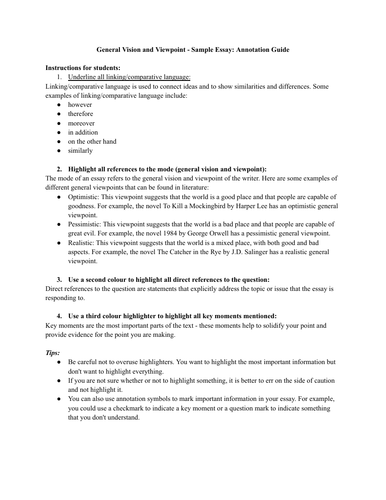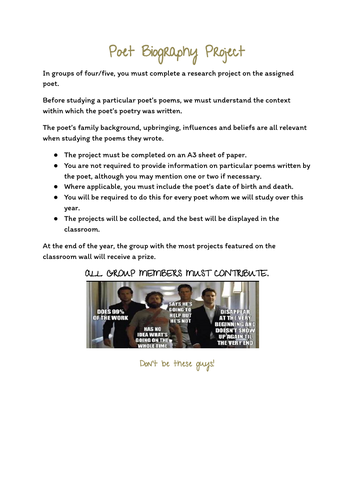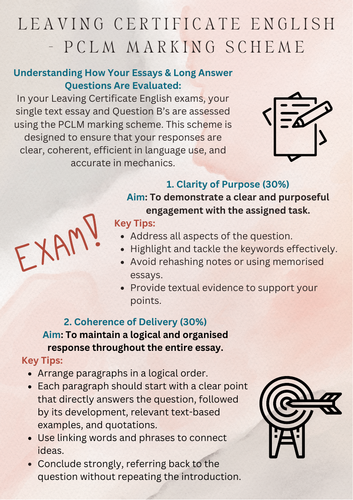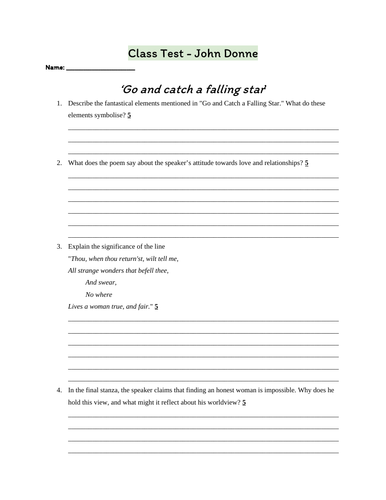
39Uploads
20k+Views
19k+Downloads
English

Barbie - Leaving Certificate Comparative Study - Higher Level
What’s Included in the Resource:
Overview: The resource begins with an overview of Barbie, directed by Greta Gerwig. It provides a plot summary, discusses the themes and messages of the film, looks at the cast, how the movie was received, and its target audience.
Detailed Plot Synopsis: A detailed synopsis of the film is included, which is perfect for students to review or as a recap for those who may not have watched it carefully.
Comprehension Questions: There are 20 questions that can be assigned to students while watching the film to check for learning and ensure they are engaged. I’ve also included a teacher answer key in a separate document to make correcting easier.
Group Discussion Questions: There are 12 critical thinking questions designed to promote higher-level thinking. Students can work in small groups and choose one question to answer, and this could take the form of a group project, class presentation, or discussion. Each question comes with a prompt to help guide the students.
Key Quotes: I’ve included a page of 15 key quotes from the film, which are useful for students to reflect on important moments and themes in the text.
Gloria’s Monologue: A full page of Gloria’s famous monologue, which is a pivotal moment in the film. This gives students a chance to highlight or annotate its significance.
Director’s Use of Satire and Gender Dynamics: A note on Greta Gerwig’s use of satire and how gender dynamics are portrayed in Barbie.
Cultural Context Section:
Setting: This discusses how the time and place in both Barbie Land and the Real World influence gender roles.
Social Class: A comparison between Barbie Land and the Real World, highlighting how class shapes the characters’ lives.
Role of Men and Women: I’ve explored how the roles of men and women differ between these worlds, looking at how patriarchy is critiqued and how modern womanhood is depicted.
General Vision and Viewpoint Section:
Optimism and Pessimism: This section analyses the overall outlook of the film, focusing on themes like light and dark, hope and despair.
Key Moments: I’ve explored the relationships, character development, and key scenes that contribute to the general vision and viewpoint of the film.
Sample Answers: I’ve included four sample answers for 30-mark Leaving Certificate questions, followed by three questions for students to complete themselves.
Additional Features:
Student Note Pages: There are colourful, interactive pages where students can write their own notes on Barbie’s cultural context and general vision and viewpoint.
Comparison Table: A simple table for students to compare all three of their texts under both modes of general vision and viewpoint and cultural context.

Once - Graphic Organiser
Introducing the perfect companion for your classroom as you delve into Morris Gleitzman’s heartwarming novel, “Once” – our one-page graphic organiser! Designed with the needs of both students and educators in mind, this A3 chart is a fantastic addition to any English teacher’s toolkit.
This meticulously crafted graphic organiser offers a unique, chapter-by-chapter breakdown of the novel. With dedicated boxes for each chapter and key characters, it allows students to comprehensively document the journey of Felix, the young protagonist, as he navigates a world filled with challenges, hope, and resilience.
But what sets our graphic organiser apart is the inclusion of captivating images and symbols that are directly related to the novel. These visual cues not only enhance comprehension but also make the learning experience more engaging and memorable.
Picture this: as you guide your students through “Once,” they’ll be able to visually connect with the story’s themes and characters right there on your classroom wall. It’s a powerful tool for sparking discussion, enhancing critical thinking, and encouraging a deeper understanding of the narrative.
As an English teacher, you know the value of well-organised teaching aids, and this graphic organiser is your key to making “Once” come alive in your classroom. Don’t miss out on the opportunity to enrich your students’ literary journey with this visually captivating resource. Order it today and let Felix’s unforgettable story unfold right before your students’ eyes!

General Vision and Viewpoint - Sample Essay and Annotation Activity
This resource is a sample H1 essay that answers the following question:
“The general vision and viewpoint of a text can be determined by the success or failure of a central character in his/her efforts to achieve fulfilment.”
In light of the above statement, compare the general vision and viewpoint in at least two texts you have studied in your comparative course.
The essay answers the question using the texts Ladybird by Greta Gerwig and Philadelphia, Here I Come! by Brian Friel.
The resource includes the following:
The essay with no annotations
Instructions and guidelines for students on how to annotate it (Finding key moments, references to the mode, references to the question, quotation marks, etc)
A copy of the essay with all annotations completed
This resource is a perfect example of how to answer the comparative study question. It is well-written, insightful, and well-argued. The annotations are clear and helpful, and they provide students with a good understanding of how to analyze a text and support their arguments with evidence.
Overall, this is an excellent resource for students who are preparing for the Leaving Certificate Exam.

Poetry Biography Project
"Poet Biography Project: Understanding the Poet’s World
This engaging project invites students to delve into the lives and backgrounds of renowned poets, gaining valuable insights into the context that shaped their poetry. Working in groups of four or five, students are tasked with researching an assigned poet and presenting their findings on an A3 sheet of paper.
Key Objectives:
Contextual Understanding: Explore the poet’s family background, upbringing, influences, and beliefs to comprehend the environment in which their poetry evolved.
Biographical Details: Include the poet’s birth and death dates where applicable.
Fostering Research Skills: Encourage students to conduct thorough research to create informative presentations.
Classroom Display: Projects will be collected, with the best ones featured prominently in the classroom.
Friendly Competition: Students will have the chance to compete, and the group with the most projects displayed at the end of the year will receive a prize.
This resource not only enhances students’ knowledge of poetry but also cultivates research and presentation skills. It offers an exciting opportunity for creative exploration and deeper comprehension of the poets whose work they’ll encounter throughout the year."

Junior Cycle Poetry
The Comprehensive Junior Cycle Poetry Teacher’s Guide
This comprehensive guide provides teachers with all the resources they need to effectively teach junior cycle poetry. It includes:
A detailed breakdown of 21 essential poetry terms, covering both basic and advanced concepts. Each term is explained clearly and concisely, with examples to illustrate its usage.
A step-by-step guide to approaching unseen poems, empowering teachers to equip their students with the skills to analyze unfamiliar pieces.
Line-by-line analysis, summaries, and junior cycle past sample answers for 11 poems from a variety of authors, including Mid-term Break, Digging, and If–. These resources provide teachers with a solid foundation for teaching these poems and help students understand their deeper meanings.
Key Features:
Comprehensive coverage of essential poetry terms
Practical strategies for approaching unseen poems
In-depth analysis of 11 selected poems
A wealth of sample student answers
Benefits:
Enhance your understanding of poetry analysis and teaching methods
Empower your students to confidently tackle unseen poetry questions
Deepen your students’ appreciation of a variety of poetry styles and themes
This teacher’s guide is an invaluable resource for educators seeking to enrich their junior cycle poetry lessons and ensure their students’ success in this challenging yet rewarding area of study.

Barbie - Ordinary Level - Leaving Certificate Comparative
Main Features of the Barbie Movie Comparative Study Resource:
Aimed specifically at Ordinary Level students for the Leaving Certificate
Focus on three comparative study modes: Relationships, Social Setting, Hero/Heroine/Villain
Overview includes a plot summary, themes, cast details, reception, and target audience insights
Detailed plot synopsis to refresh students’ memory or support those who may not have watched the film closely
Comprehension questions (20 in total) for students to answer while watching the film, with a teacher answer key included
Group discussion questions (12) designed for small groups, encouraging higher-order thinking and class presentations
Key quotes from the film, along with Gloria’s Monologue, allowing for annotation and analysis
Comparative modes:
Social Setting: Includes four sample answers and three student questions
Relationships: Explores Barbie & Ken, Gloria & Sasha, with four sample answers and four student questions
Hero, Heroine, and Villain: Focus on Barbie and Ken/patriarchy, with sample answers and questions for students
Student note pages: Colourful, interactive pages for students to jot down their own notes on the key modes
Comparison table for students to record keywords and notes across all three texts and modes
This resource is engaging, accessible, and designed to deepen student understanding of Barbie within the comparative study framework.

Pre-reading - Salem Witch Trials Web-Quest
Resource Description:
Explore History with a Modern Twist – The Salem Witch Trials Web Quest!
Step back in time and immerse yourself in the enigmatic era of the Salem Witch Trials through this engaging and interactive web quest. Designed for today’s tech-savvy students, this resource allows them to use their smartphones as powerful tools for historical exploration.
Key Features:
Mobile-Friendly: This web quest is specifically designed for smartphones, making it accessible and engaging for today’s students who are always on the go.
Solo or Teamwork: Students can choose to embark on this journey individually or collaborate with a partner, fostering both independence and teamwork skills.
In-Depth Exploration: Through a series of thought-provoking questions and challenges, students will delve deep into the history, context, and intricacies of the Salem Witch Trials.
Historical Context: Gain insights into the social, cultural, and religious factors that contributed to the witch trials of the late 1600s.
Interactive Challenges: Interactive elements and multimedia resources provide an immersive learning experience that goes beyond traditional textbooks.
Critical Thinking: Encourage critical thinking and analysis as students work their way through a series of inquiries and puzzles.
Flexible Learning: Ideal for in-class use, homework assignments, or as an extra credit opportunity, allowing for flexible integration into your curriculum.
By using their smartphones as research tools, students will not only expand their knowledge of history but also enhance their digital literacy skills. Unlock the mysteries of the Salem Witch Trials in a way that resonates with today’s tech-savvy generation. Embrace the power of modern technology to make history come alive!

Unlocking Literary Magic: 13 Essential Literary Terms
Dive into the enchanting world of literature with our colorful and engaging resource designed for students in Junior Cycle through Ordinary Leaving Certificate English. “Unlocking Literary Magic” is your key to understanding and mastering 13 essential literary terms that will transform your reading and writing skills.
What’s Inside:
Alliteration: Discover the power of sound in literature. Alliteration occurs when words with the same initial consonant sounds are used close together, like “Sally sells seashells by the seashore.”
Assonance: Explore the musical side of words. Assonance is the repetition of vowel sounds in nearby words, such as “fleet feet sweep by sleeping geese.”
Hyperbole: Experience the exaggeration. Hyperbole uses extravagant language to emphasize a point, like “I’m so hungry I could eat a horse!”
Metaphor: Uncover hidden meanings. A metaphor compares two unlike things without using “like” or “as,” e.g., “Her smile is a ray of sunshine.”
Onomatopoeia: Hear the words come alive. Onomatopoeia imitates sounds, like “buzz,” “meow,” or “boom.”
Personification: Breathe life into objects. Personification gives human characteristics to non-human things, such as “The wind whispered through the trees.”
Sibilance: Savor the sound of hissing. Sibilance is the repetition of hissing “s” and “sh” sounds, creating a serene or sinister atmosphere.
Rhyme: Dance to the rhythm of words. Rhyme is the repetition of similar sounds in words, like “cat” and “hat.”
Rhetorical Questions: Engage your readers. Rhetorical questions are asked for effect or to provoke thought, not necessarily to receive an answer, such as “Who doesn’t love a good story?”
Imagery: Paint pictures with words. Imagery uses vivid descriptions to appeal to the senses, like “The aroma of freshly baked bread filled the air.”
Simile: Make comparisons sparkle. A simile compares two things using “like” or “as,” such as “Brave as a lion.”
Repetition: Emphasize, emphasize, emphasize. Repetition involves repeating words or phrases for impact, like “Never, never, never give up” (Winston Churchill).
Symbolism: Decipher hidden meanings. Symbolism is the use of symbols or objects to represent deeper ideas, like a dove representing peace.
Why You’ll Love It:
Colorful and visually appealing.
Concise definitions and clear examples.
Helpful for essays, exams, and creative writing.
Enhance your literary analysis skills.

2017 - Question B - Sample Answer
QUESTION B
**Your school Principal has agreed to your suggestion to display three poems, or extracts from three poems, on the 2017 Leaving Certificate Higher Level English poetry course, in your school. You have been asked to choose the poetry and decide how and where it will be displayed. Write an article for your school’s website in which you explain your choice of poetry, your ideas for its display and the impact you hope this project will have on the school community. (50)

The Outsiders - Graphic Oraniser
Introducing the ideal companion for your classroom when exploring “The Outsiders” - our one-page graphic organiser! This meticulously crafted A3 chart is designed with both students and teachers in mind, catering to the needs of educators like you who are passionate about teaching English.
This comprehensive graphic organiser is a valuable tool for dissecting S.E. Hinton’s classic novel. It’s ingeniously structured, with a dedicated box for each chapter, enabling students to record key events, character developments, and central themes as they read. What sets it apart is its adaptability, offering three flexible boxes for teachers to customise – whether for novel feedback, concise reviews, or memorable quotes from the text.
But that’s not all; we’ve incorporated captivating images and symbols related to ‘The Outsiders’ into the design, enhancing visual engagement and aiding memory retention. Hang it proudly on your classroom wall, turning it into an attractive and informative centerpiece for your students.
As an English teacher, you understand the value of visual aids and organised note-taking, and this graphic organiser is your perfect ally in the teaching journey. It will guide your students through the novel’s intricate narrative, making their learning experience not only more engaging but also more effective. So why wait? Elevate your “The Outsiders” lessons with this indispensable tool today.

Tips for Effective Question B Presentation
Description:
This resource comprises ten informative slides designed to help Leaving Certificate students effectively approach Question B on their exam paper. Question B is a critical component of the examination, and this resource offers a concise yet comprehensive overview of how to tackle it successfully.

Leaving Certificate English - PCLM Marking Scheme
This two-page worksheet breaks down the PCLM marking scheme into easily digestible insights, helping you understand how your essays are assessed.

Introduction to OL English
An introduction to the OL English course for 5th year students and a guide on what texts to purchase and where.
Follow @rescueresource on instagram for an editable version of this resource!

Louder than Words - First Year Scheme of Work
This scheme of work covers the academic year and includes a diverse range of texts and activities to engage and develop students’ language skills. It encompasses poetry, drama, novels, short stories, oral texts, and written communication. The curriculum aims to enhance critical thinking, language proficiency, and a deep appreciation for literature and communication skills. It is divided into thematic units with specific learning outcomes and assessments.

John Donne - Ordinary Level - Class Test
This resource is a “Weekly Test” for the study of John Donne’s poems, specifically focusing on “Go and Catch a Falling Star” and “The Flea.” It is designed for students, particularly those preparing for Irish Leaving Certificate at Ordinary Level. The test consists of a series of structured questions that encourage critical thinking and analysis of these two poems.
For “Go and Catch a Falling Star,” students are asked to describe the fantastical elements in the poem and analyze their symbolism. They also explore the speaker’s attitude towards love and relationships, the significance of a repeated line, and the speaker’s view of honesty in women.
For “The Flea,” students examine the central metaphor and how it is used for persuasion, the symbolism of the flea in the lovers’ relationship, the speaker’s feelings about physical intimacy, and the significance of a specific line. Additionally, they are prompted to share their impression of the speaker based on their reading of the poem.
The test provides a total score out of 60 and includes space for a parent’s signature, indicating its suitability for classroom use or as a practice resource for students preparing for their exams.

Ordinary Level Comparative Revision - Where the Crawdads Sing and The Shawshank Redemption
This comprehensive 36-page document delves into a detailed comparison of two prominent texts featured in the Leaving Certificate comparison course: “The Shawshank Redemption” by Frank Darabont and “Where the Crawdads Sing” by Delia Owens. Focused on the thematic elements of Isolation and the dynamic portrayal of Hero, Heroine, and Villain, this resource provides an in-depth exploration of both texts, offering valuable insights for students and teachers alike.
Content Highlights:
Thematic Comparison: Explores the theme of Isolation in both texts, dissecting how this theme is depicted, its significance, and its impact on characters and narrative development.
Character Analysis: Provides comprehensive character notes for key figures in each text, shedding light on their motivations, complexities, and roles within the themes of Isolation and Hero, Heroine, Villain.
Key Moments Examination: Breaks down pivotal moments in both texts, highlighting scenes that intricately illustrate themes of Isolation and the portrayal of heroic, villainous, and protagonist characters.
Quotations Analysis: Presents key quotes from the texts, analysing their contextual significance, thematic relevance, and how they contribute to character development and storytelling.
Sample Answers: Offers sample answers to exemplify how to structure responses, drawing comparisons between the texts based on the themes and characters explored.
Benefits for Students and Teachers:
Comprehensive Analysis: Provides an in-depth study of themes and characters in both texts, aiding a thorough understanding for students preparing for exams.
Educational Guidance: Offers teachers a valuable resource for structuring lesson plans and guiding students through comparative analysis.
Exam Preparation: Equips students with valuable insights, character notes, and sample answers to enhance their exam preparation and essay writing skills.
This resource serves as an invaluable tool for those studying and teaching the Leaving Certificate comparative course, offering a detailed exploration of thematic elements and character dynamics across two compelling texts.**

Merchant of Venice class test and Revision Notes
*EDITED Apologies! Notes were created using an inaccurate version so there were three errors that have been noted and corrected! Apologies!
*
Class test (1hr class)
The test comprises five sections, each addressing specific aspects of William Shakespeare’s play “The Merchant of Venice.”
Section 1: Plot Structure
Requires identifying the key components of Freytag’s Pyramid (Exposition, Rising Action, Climax, Falling Action, Denouement) within the play. Specific examples from the text are requested to support the identification of each component.
Section 2: Character Relationships
Focuses on the relationship between Antonio and Shylock, inquiring how this relationship contributes to the overall conflict in the play. A separate question explores the impact of the friendship between Bassanio and Antonio on the plot and characters.
Section 3: Tension in a Scene
Asks for an analysis of the scene with the most tension in the play. The student is prompted to describe the setting, characters involved, factors contributing to the tension, and how the tension is ultimately resolved within that scene.
Section 4: Themes
Explores the themes of mercy and justice in the play. It asks for examples of characters or scenes embodying these themes and how they contribute to the overall message of the play. Another question addresses the impact of prejudice on Shylock and his interactions with others.
Section 5: Key Plot Details
Examines the significance of the casket test within the play, focusing on its impact on the plot and characters. Another question prompts students to recall the events leading up to the courtroom scene and analyze how the trial affects the characters and resolves the play’s conflicts.
Overall, the test aims to evaluate students’ understanding of the plot structure, character relationships, thematic elements, and significant plot details within “The Merchant of Venice.” Students are required to provide specific examples and detailed explanations to demonstrate their comprehension of the play’s nuances and themes.
Revision Notes Document:
The revision notes serve as a study guide summarising essential themes, character dynamics, key scenes, and their significance within the play.
It explores and analyses various elements, including the relationship between Antonio and Shylock, the impact of friendship between Bassanio and Antonio, themes of mercy and justice, the concept of prejudice and its effects on Shylock, the significance of the casket test, and the pivotal courtroom scene.
Both documents collectively provide a comprehensive resource for students preparing for the Junior Certificate exam. The test offers a structured way to assess students’ understanding of the play’s narrative structure, while the revision notes consolidate key themes, character relationships, and significant scenes, aiding in a deeper understanding and analysis of the text.

PQE - Step by Step for Junior Cycle students
This resource is designed to assist English students and teachers in enhancing their question-answering skills by following the structured PQE approach. The resource is divided into sections that cover the fundamentals of this writing method. It includes explanations, practical tips, and examples to help users develop effective responses to questions. This valuable resource can aid both students and teachers in the classroom, empowering them to craft well-supported and reasoned answers.


















